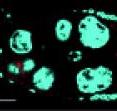Need for speed
Like any law-abiding train passenger, a molecule called oskar RNA carries a stamped ticket detailing its destination and form of transport, scientists at the European Molecular Biology Laboratory (EMBL) in Heidelberg, Germany, have found. They show that for this molecule, moving in the right direction isn't enough: speed is of the essence. Their study, published online March 18 in Nature Structural & Molecular Biology, also provides clues as to how a single molecule could receive tickets for different destinations, depending on what type of cell it is in. For a fruit fly embryo to develop properly, oskar RNA produced by the mother has to enter the egg cell, or oocyte, as it matures, and be taken to one of its ends -- the posterior pole. Researchers in Anne Ephrussi's group at EMBL have now found that this movement is more complicated than it seemed. When oskar is processed for transport by a mechanism called splicing, two different tags -- SOLE and EJC -- are attached to it, next to each other, at a specific spot. Ephrussi and colleagues found that both tags have to be in place for oskar to reach the right destination. Together, they seem to form a ticket that marks oskar for transport to the posterior pole, differentiating it from the many other RNAs that enter the oocyte bound for different destinations.
When they genetically altered the SOLE tag, the scientists found that oskar didn't go to the oocyte's posterior pole, as it should. But surprisingly, it did still move, and seemingly in the right direction. The problem, the researchers realised, was that oskar is racing towards a moving target. As the oocyte grows, it becomes longer, in effect taking the posterior pole further and further away as oskar is carried towards it. With a defective SOLE tag, oskar seemed unable to move fast enough to overcome the oocyte's growth. So somehow this 'ticket' affects the speed of transport, too.
Ephrussi and colleagues are now investigating how SOLE and EJC interact with each other, and how they might influence the cellular machinery that transports oskar. The scientists would also like to explore an interesting possibility raised by their current findings. They discovered that the SOLE tag is only formed if the RNA molecule is spliced. Since some RNAs can be spliced at different spots along their length, this means the same RNA could potentially be issued with tickets for different destinations -- for instance, in different cell types -- depending on which parts of it are spliced.
Source: European Molecular Biology Laboratory (EMBL)
Other sources
- Need for speed: Molecular ticket determines RNA’s destination and speed inside egg cellfrom Science DailySun, 18 Mar 2012, 20:30:54 UTC
- Molecular ticket determines RNA's destination and speed inside egg cellfrom PhysorgSun, 18 Mar 2012, 18:00:30 UTC
